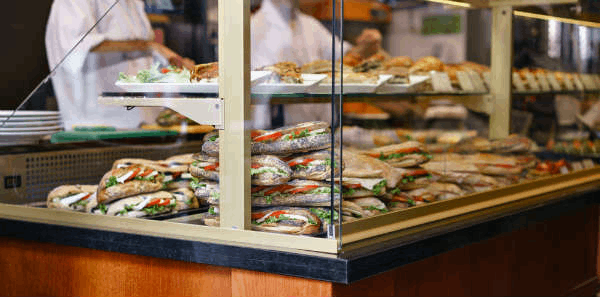How to create a financial forecast for a deli?
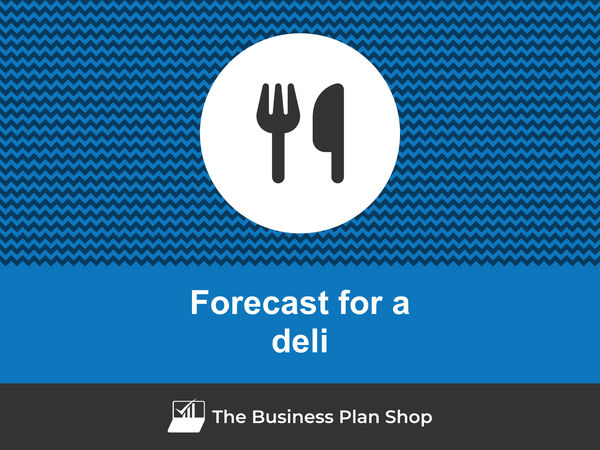
Developing and maintaining an up-to-date financial forecast for your deli is key in order to maintain visibility on your business’s future cash flows.
If you feel overwhelmed at the thought of putting together a deli financial forecast then don’t worry as this guide is here to help you.
We'll cover everything from: the main objectives of a financial forecast, the data you need to gather before starting, to the tables that compose it, and the tools that will help you create and maintain your forecast efficiently.
Let's get started!
Why create and maintain a financial forecast for a deli?
The financial projections for your deli act as a financial blueprint to guide its growth with confidence and ensure its long-term financial viability.
To create them, you will need to look at your business in detail - from sales to operating costs and investments - to assess how much profit it can generate in the years to come and what will be the associated cash flows.
During challenging market conditions, maintaining an up-to-date financial forecast enables early detection of potential financial shortfalls, allowing for timely adjustments or securing financing before facing a cash crisis.
Your deli's financial forecast will also prove invaluable when seeking financing. Banks and investors will undoubtedly request a thorough examination of your financial figures, making precision and presentation essential.
Need a solid financial forecast?
The Business Plan Shop does the maths for you. Simply enter your revenues, costs and investments. Click save and our online tool builds a three-way forecast for you instantly.

What information is used as input to build a deli financial forecast?
A deli's financial forecast needs to be built on the right foundation: your assumptions.
The data required to create your assumptions will depend on whether you are a new or existing deli.
If you are creating (or updating) the forecast of an existing deli, then your main inputs will be historical accounting data and operating metrics, and your team’s view on what to expect for the next three to five years.
If you are building financial projections for a new deli startup, you will need to rely on market research to form your go-to-market strategy and derive your sales forecast.
For a new venture, you will also need an itemised list of resources needed for the deli to operate, along with a list of equipment required to launch the venture (more on that below).
Now that you understand what is needed, let’s have a look at what elements will make up your deli's financial forecast.
The sales forecast for a deli
From experience, it is usually best to start creating your deli financial forecast by your sales forecast.
To create an accurate sales forecast for your deli, you will have to rely on the data collected in your market research, or if you're running an existing deli, the historical data of the business, to estimate two key variables:
- The average price
- The number of monthly transactions
To get there, you will need to consider the following factors:
- Seasonal Demand: The demand for deli products can vary greatly depending on the time of the year. For example, during the summer months, there may be an increase in sales due to more people going on picnics and outdoor gatherings.
- Local Events: Your deli's location can play a significant role in the number of monthly transactions. If your deli is located near a popular event venue, such as a concert hall or sports arena, you may experience an increase in sales during events.
- Menu Changes: Introducing new items or changing prices on existing items can impact your deli's average price and number of transactions. For example, if you add a new specialty sandwich to your menu at a higher price point, it may increase your average price but could also lead to a decrease in the number of transactions.
- Local Competition: The presence of other delis or similar establishments in the area can affect your business's sales. If there is a new deli opening nearby, it could potentially draw customers away from your deli, leading to a decrease in sales.
- Economic Conditions: Changes in the economy, such as a recession or inflation, can greatly impact consumer spending habits and, therefore, your deli's sales. In times of economic downturn, people may be more likely to opt for cheaper options, which could result in a decrease in your average price and number of transactions.
Once you have an idea of what your future sales will look like, it will be time to work on your overhead budget. Let’s see what this entails.
Need inspiration for your business plan?
The Business Plan Shop has dozens of business plan templates that you can use to get a clear idea of what a complete business plan looks like.

The operating expenses for a deli
The next step is to estimate the expenses needed to run your deli on a day-to-day basis.
These will vary based on the level of sales expected, and the location and size of your business.
But your deli's operating expenses should include the following items at a minimum:
- Staff costs: This includes the salaries and wages of your employees, as well as any benefits or bonuses they may receive.
- Accountancy fees: You may need to hire an accountant to help you manage your finances and taxes.
- Insurance costs: Running a deli comes with certain risks, so it's important to have insurance to protect your business.
- Software licenses: You may need to purchase software for tasks such as inventory management, point of sale systems, and bookkeeping.
- Banking fees: You will likely have to pay fees for things like business bank accounts, credit card processing, and cash deposits.
- Rent: Unless you own the property, you will have to pay rent for your deli location.
- Utilities: This includes expenses like electricity, water, and gas for your deli.
- Inventory: You will need to regularly purchase ingredients and supplies to keep your deli stocked.
- Marketing and advertising: To attract customers, you may need to spend money on marketing and advertising efforts.
- Repairs and maintenance: As with any business, your deli may require repairs and maintenance from time to time.
- Cleaning services: To maintain a clean and hygienic environment for your customers, you may need to hire cleaning services.
- Packaging and labeling: If you offer take-out options, you will need to purchase packaging materials and labels.
- Training and development: Investing in training and development for your employees can help improve the quality of your deli's products and services.
- Licenses and permits: You may need to obtain various licenses and permits to legally operate your deli.
- Taxes: As a business owner, you will be responsible for paying various taxes, such as income tax and sales tax.
This list is, of course, not exhaustive, and you'll have to adapt it according to your precise business model and size. A small deli might not have the same level of expenditure as a larger one, for example.
What investments are needed to start or grow a deli?
Creating and expanding a deli also requires investments which you need to factor into your financial forecast.
Capital expenditures and initial working capital items for a deli could include elements such as:
- Equipment: This includes items such as commercial refrigerators, ovens, fryers, and other kitchen equipment that are necessary for running a deli.
- Furniture and Fixtures: This includes tables, chairs, and other furniture needed for the dining area, as well as shelving and display cases for showcasing deli products.
- Renovations and Improvements: This includes any necessary renovations or improvements to the deli space, such as painting, flooring, or building additions to accommodate for increased business.
- POS System: A Point of Sale (POS) system is essential for tracking sales, managing inventory, and processing payments. This is a vital capital expenditure for any deli.
- Vehicles: If the deli offers catering services or delivers food, a vehicle may be needed for transportation. This would be considered a capital expenditure for the deli.
Again, this list is not exhaustive and will need to be adjusted according to the circumstances of your deli.
Need a convincing business plan?
The Business Plan Shop makes it easy to create a financial forecast to assess the potential profitability of your projects, and write a business plan that’ll wow investors.

The financing plan of your deli
The next step in the creation of your financial forecast for your deli is to think about how you might finance your business.
You will have to assess how much capital will come from shareholders (equity) and how much can be secured through banks.
Bank loans will have to be modelled so that you can separate the interest expenses from the repayments of principal, and include all this data in your forecast.
Issuing share capital and obtaining a bank loan are two of the most common ways that entrepreneurs finance their businesses.
What tables compose the financial plan for a deli?
Now let's have a look at the main output tables of your deli's financial forecast.
The profit & loss forecast
The forecasted profit & loss statement will enable you to visualise your deli's expected growth and profitability over the next three to five years.
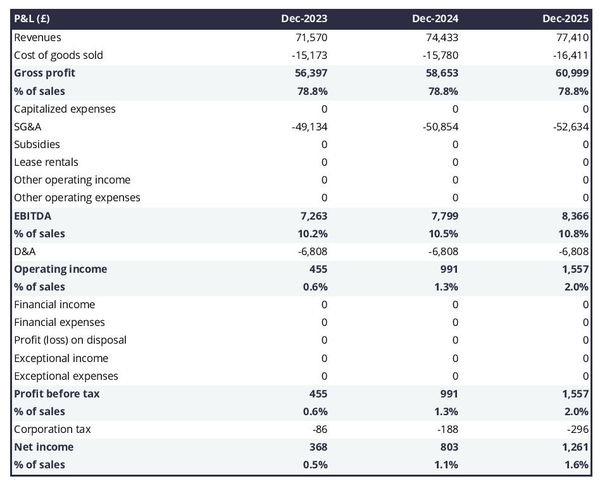
A financially viable P&L statement for a deli should normally show:
- Sales growing above inflation
- Stable or expanding (ideally) profit margins
- A net profit
This will of course depend on the stage of your business: a new venture might be loss-making until it reaches its breakeven point in year 2 or 3, for example.
The projected balance sheet
Your deli's forecasted balance sheet enables you to assess your financial structure and working capital requirements.
It is composed of three types of elements: assets, liabilities and equity:
- Assets: represent what the business owns and uses to produce cash flows. It includes resources such as cash, equipment, and accounts receivable (money owed by clients).
- Liabilities: represent funds advanced to the business by lenders and other creditors. It includes items such as accounts payable (money owed to suppliers), taxes due and loans.
- Equity: is the combination of what has been invested by the business owners and the cumulative profits and losses generated by the business to date (which are called retained earnings). Equity is a proxy for the value of the owner's stake in the business.
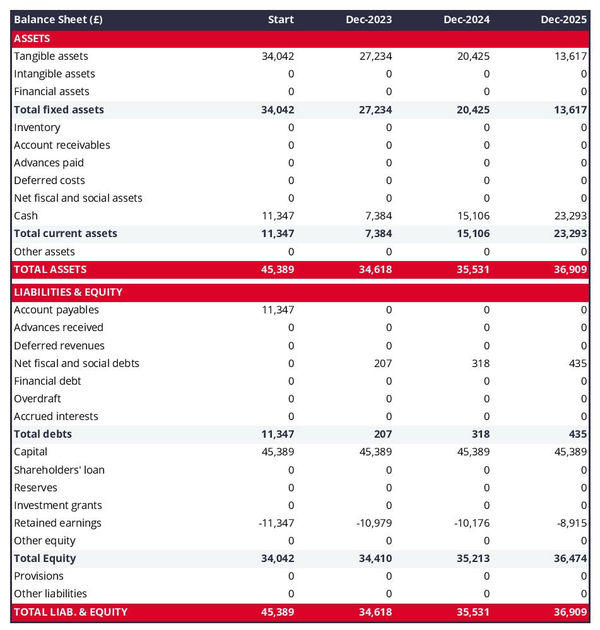
The cash flow forecast
Your deli's cash flow forecast shows how much cash your business is expected to consume or generate in the years to come.
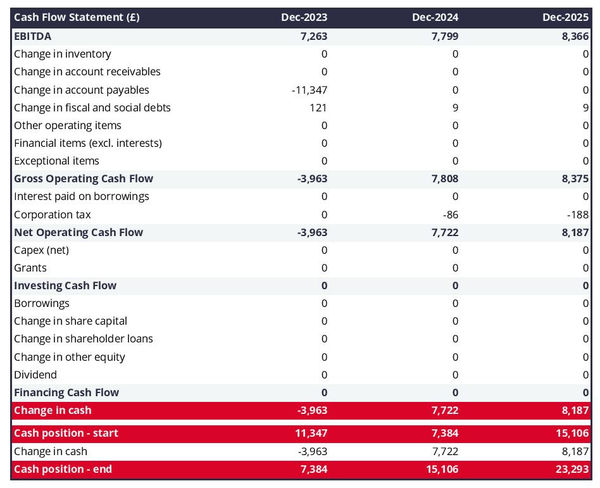
It is best practice to organise the cash flow forecast by nature to better explain where cash is used or generated by the deli:
- Operating cash flow: shows how much cash is generated by the operating activities
- Investing cash flow: shows how much will be invested in capital expenditure to maintain or expand the business
- Financing cash flow: shows if the business is raising new capital or repaying financiers (debt repayment, dividends)
Keeping an eye on (and regularly updating) your deli's cash flow forecast is key to ensuring that your business has sufficient liquidity to operate normally and to detect financing requirements as early as possible.
If you are trying to raise capital, you will normally be asked to provide a monthly cash flow forecast in your deli's financial plan - so that banks or investors can assess seasonal variation and ensure your business is appropriately capitalised.
Need a solid financial forecast?
The Business Plan Shop does the maths for you. Simply enter your revenues, costs and investments. Click save and our online tool builds a three-way forecast for you instantly.

Which tool should you use to create your deli's financial forecast?
Using the right tool or solution will make the creation of your deli's financial forecast much easier than it sounds. Let’s explore the main options.
Using online financial forecasting software to build your deli's projections
The modern and easiest way is to use an online financial forecasting tool such as the one we offer at The Business Plan Shop.
There are several advantages to using specialised software:
- You can easily create your financial forecast by letting the software take care of the financial calculations for you without errors
- You have access to complete financial forecast templates
- You get a complete financial forecast ready to be sent to your bank or investors
- You can easily track your actual financial performance against your financial forecast, and recalibrate your forecast as the year goes by
- You can create scenarios to stress test your forecast's main assumptions
- You can easily update your forecast as time goes by to maintain visibility on future cash flows
- You have a friendly support team on standby to assist you when you are stuck
- It’s cost-efficient and much cheaper than using an accountant or consultant (see below)
If you are interested in this type of solution, you can try our projection software for free by signing up here.
Calling in a financial consultant or chartered accountant
Enlisting the help of a consultant or accountant is also a good way to obtain a professional deli financial forecast.
The downside of this solution is its cost. From experience, obtaining a simple financial forecast over three years (including a balance sheet, income statement, and cash flow statement) is likely to cost a minimum of £700 or $1,000.
The indicative cost above, is for a small business, and a forecast is done as a one-shot exercise. Using a consultant or accountant to track your actuals vs. forecast and to keep your financial projections up to date on a monthly or quarterly basis will cost a lot more.
If you opt for this solution, make sure your accountant has in-depth knowledge of your industry, so that they may challenge your figures and offer insights (as opposed to just taking your assumptions at face value to create the forecast).
Why not use a spreadsheet such as Excel or Google Sheets to build your deli's financial forecast?
Creating an accurate and error-free deli financial forecast with a spreadsheet is very technical and requires a deep knowledge of accounting and an understanding of financial modelling.
Very few business owners are financially savvy enough to be able to build a forecast themselves on Excel without making mistakes.
Lenders and investors know this, which is why forecasts created on Excel by the business owner are often frowned upon.
Having numbers one can trust is key when it comes to financial forecasting and to that end using software is much safer.
Using financial forecasting software is also faster than using a spreadsheet, and, with the rise of artificial intelligence, software is also becoming smarter at helping us analyse the numbers to make smarter decisions.
Finally, like everything with spreadsheets, tracking actuals vs. forecasts and keeping your projections up to date as the year progresses is manual, tedious, and error-prone. Whereas financial projection software like The Business Plan Shop is built for this.
Need a convincing business plan?
The Business Plan Shop makes it easy to create a financial forecast to assess the potential profitability of your projects, and write a business plan that’ll wow investors.

Use our financial projection templates for inspiration
The Business Plan Shop has dozens of financial forecast templates available.
Our examples contain a complete business plan with a financial forecast and a written presentation of the company, the team, the strategy, and the medium-term objectives.
Whether you are just starting out or already have your own deli, looking at our financial forecast template is a good way to:
- Understand what a complete business plan should look like
- Understand how you should model financial items for your deli

Takeaways
- A financial projection shows expected growth, profitability, and cash generation for your business over the next three to five years.
- Tracking actuals vs. forecast and keeping your financial forecast up-to-date is the only way to maintain visibility on future cash flows.
- Using financial forecasting software makes it easy to create and maintain up-to-date projections for your deli.
You have reached the end of our guide. We hope you now have a better understanding of how to create a financial forecast for a deli. Don't hesitate to contact our team if you have any questions or want to share your experience building forecasts!
Need inspiration for your business plan?
The Business Plan Shop has dozens of business plan templates that you can use to get a clear idea of what a complete business plan looks like.

Also on The Business Plan Shop
Know someone who runs or wants to start a deli? Share our financial projection guide with them!



